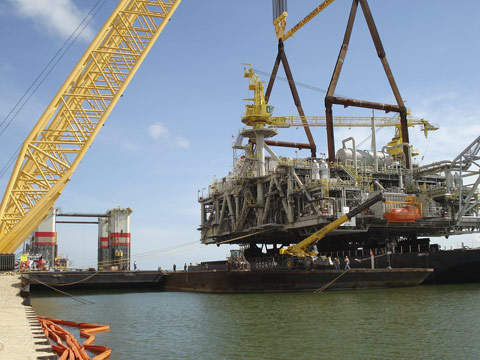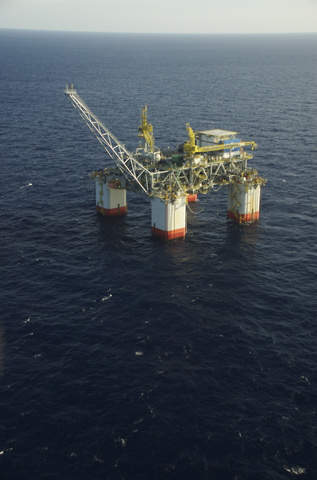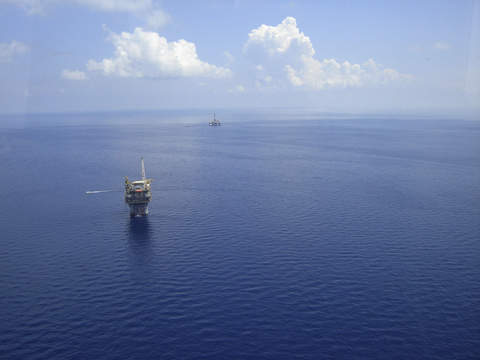The K2 field is located in Green Canyon Blocks 518 and 562 about 175 miles south of New Orleans, Louisiana, at a water depth of 4,326ft. K2 holds an estimated oil reserves of 100 million boe. K2 is one of the first deepwater subsalt Miocene fields to start production from reservoir depths beneath 25,000ft sub-sea true vertical depth.
K2 is operated by Anadarko Petroleum which holds 41.8% working interest in the field. Other stakeholders in K2 include Ecopetrol (9.21%), Nippon (11.6%), MCX (11.6%), ConocoPhillips (12.4%) and ENI 13.4%. Produce from K2 is processed at Anadarko’s Marco Polo TLP in Green Canyon block 608, located seven miles from K2.
Geology
The K2 oil field is a large salt cored compressional anticline structure surrounded by a 10,000-12,000ft thick salt canopy. A crestal normal fault splits the field into north and south fault blocks.
The K2 field consists of two main reservoirs, M14 and M20, with turbidite sheet deposits of Miocene age. The M14 is a single clean sand of up to 100ft thickness with a high net to gross pay ratio. The permeability of the field averages 700md and porosity averages 23%.
The M20 comprises two main reservoirs, M20 Upper and M20 Lower, with 30ft-thick sealing shale separating them. The gross thickness of M20 can be more than 350ft and gross ratios range from 60% to 80%. Permeability of M20 ranges between 100md and 10,000md and porosities range between 17% and 28%.
The reservoir dip ranges from 25° near the crest to 20° at the flank and pressures range from 12,800-15,000psia.
The hydrocarbons in the reservoirs are trapped in a three-way fault closure against the undip salt. They are characterised as highly undersaturated, medium to high asphaltene oils with low to medium gas oil ratios.
Field development
The K2 field was originally discovered in 1999 by Conoco and in 2000 ENI became the operator. Initial development of K2 was taken up in Green Canyon block 562 by drilling sub-sea wells GC 562 1, 2, 3. Field development was undertaken after the project was sanctioned in 2004.
Development activities included sidetracking of the three wells below the 9-7/8″ production casing at 22,000ft to 26,000ft TVD, running 7-3/4in production casing, running 9-7/8in production casing tie-back to the subsea well head. Several challenges including loop current, hurricanes Lillie, Katrina and Rita, shallow water flow zones and drilling through 10,000ft of salt were faced during the development of the K2 field.
Production from GC 562 3 well first began in May 2005. By 2006 all three wells were on production using sub-sea tiebacks to the Marco Polo TLP. Development of the K2 North field was taken up by Anadarko with the drilling of wells GC 518 1, 2, 3. By 2006, all three wells started production using tiebacks to the Marco Polo TLP.
In July 2006, both K2 and K2 North fields were unitised by all working interest parties and in January 2007 Anadarko was appointed the operator.
In March 2009, Anadarko announced development of two wells in Green Canyon blocks 606 and 562 at the K2 field. The first well, GC 606 1, is situated in approximately 4,150ft of water and was tested at 4,000 BOE/d. The well found 110ft of net hydrocarbon pay in three middle- and lower-miocene sands. Anadarko also started completion operations on the GC 562 4 sidetrack 3 well, which is located at a water depth of 4,000ft.
The GC 606 1 and GC 562 4 wells are expected to be completed and go into production in the third quarter of 2009. The two wells will be tied back to the Marco Polo platform. Flowlines and umbilicals are being installed in the field.
Flowline and riser system
To transfer oil from three wells in K2 field dual 7in/12in pipe-in-pipe flowlines were used through 7in heavy-wall Steel Catenary Risers (SCRs), to the Marco Polo TLP.
The pipe-in-pipe flowlines, insulated with a new nanoporous substance, were fabricated onshore and installed by the reel-lay method.
Two four-hub Pipeline End Terminations (PLETs) and two dual-hub In-Line Tees were used to tie-in the wells with 6in well jumpers. A piggable loop was fitted by fabricating and putting in a non-standard 7in jumper arrangement within the PLETs.
The riser quad joints, insulated with two new product formulations, were fabricated onshore and fitted through the Jlay method.
Contracts
Technip, a company which provides engineering, technologies and project management for the oil and gas industry, was given the contract for the K2 field expansion project. The project involves tieback of the GC 606 1 and the GC 562 4 wells to the existing subsea equipment and to the Marco Polo platform with production flowlines.
Technip will be responsible for project management and engineering, manufacture and installation of two rigid flowlines. The company will also be responsible for design, manufacture and installation of four PLETs. Other services which the company will provide include establishing two free issue static umbilicals, tie-ins, pre-commissioning and survey.
The flowlines will be joined at Technip’s spoolbase at Mobile, Alabama. Offshore installation will take place in the third quarter of 2009, with the help of Deep Blue, Technip’s deepwater pipelay vessel.










